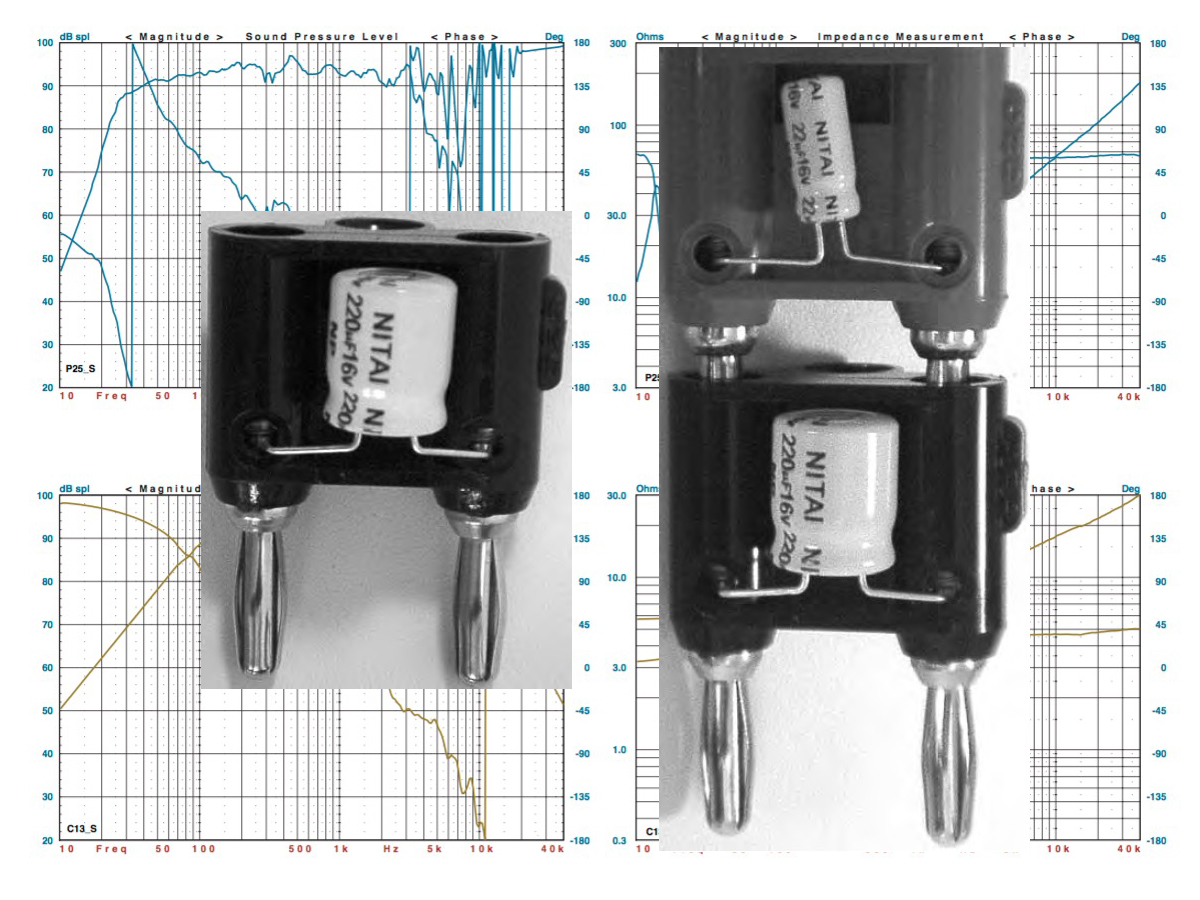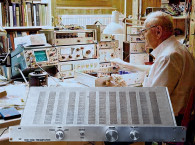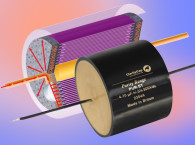Assuming you have completed a computer-based crossover design, you will have a set of finalized-in-software component values —inductors, capacitors, and resistors — that are ready to be realized in a prototype. When you build a prototype at this stage, you will typically find it more appropriate to validate and fine-tune the results by playing around with the capacitors rather than the inductors.
With inductors being bulkier and more expensive, it is usually more practical to design a crossover around standard inductor values and use capacitors in parallel to fine-tune the crossover characteristics, rather than the other way round. This observation was an important consideration for me in arriving at an effective prototyping model.
Alligator clips and breadboards are two popular ways to produce a prototype. However, my experience was that the plug-and-play process using these methods can be quite cumbersome for the experimenter and quite taxing for the components involved, too. It is not a pleasant experience to render an audiophile-grade capacitor with bent, weakened, or broken leads after a few plug-and-play operations using traditional breadboards or alligator clips.
Is there a way to effortlessly and reliably plug and play with a set of (fixed) capacitors across crossover prototypes without the fear of ending up with broken leads? This question drove me to design this passive crossover prototyping system.
It would be appropriate to point out that this prototyping system involves a nontrivial investment of money, but if you are someone who builds more than a couple of prototypes a year, you will find that this system makes your job much easier and quickly pays for itself.

As Photo 1 shows, the central idea is to have each capacitor mounted on a dual 4mm stacking banana plug. I used a Pomona MDP, which is a solderless type with set screws. Another possibility is Pomona 1330-ST, which comes with solder turrets. The use of stacking banana plugs helps in multiple ways:
• First, the contact resistances are of the order of a few milliohms each—very important when you are dealing with signal paths that are of the order of just several tens or hundreds of milliohms.
• Second, once you fix the capacitor or resistor to the banana plug, the act of handling the capacitor leads is done with once and for all: in all future plug-and-play operations you handle only the banana plug. This means that you can plug and play as much as you wish without fear of component damage or contact deterioration.
• Third—and this is key to the rapid prototyping ability — you can easily build up the desired capacitor values by simply stacking up the capacitor-on-banana plug (COB) combination.
Photo 2 shows a pair of stacked-up COBs. If you are using banana plugs with set screws, experiment first with a couple of throwaway capacitors to assess the “fit” of the screw. All the Pomonas I used held the component leads very snugly indeed, but I had somewhat less ecstatic experiences with less expensive brands of plug.
Quality banana plugs such as Pomona’s when purchased in retail are pretty expensive — about $3 a piece. It might initially seem strange to mate a $3 plug with a capacitor of similar or perhaps even lesser value, but those three advantages make for a good return on investment as you go. It is certainly worthwhile to do some research and smart shopping for surplus plugs for this purpose.
I managed to get a few dozen new Pomona plugs from eBay for as little as $10 for a dozen, which is less than a buck a piece. Some savings! In my experience the 4mm sockets are probably less critical than the plugs. You should be able to use more or less any brand that is easily available, especially as surplus stock. I used a standard nickel-plated 4mm socket-cum-binding post with solder tags.

The choice of material for the board is not critical: I used a 3mm phenolic board, but you may choose to use 3mm hardboard, for example. The board I used measured about 15 × 12˝ and holds enough sockets for prototyping three-way 18dB/octave parallel crossovers. Photo 3 shows the component side layout of the completed system, and Photo 4 shows the reverse side with interconnections. The overall layout of the board can resemble the topology of the way you would schematically draw the crossover. I can also use this system for two-way and lower order crossovers simply by plugging appropriate shorting cables on the component side attached to 4mm banana plugs, or by affixing them to the binding posts.
During construction it is important to make sure you drill carefully to account for the spacing between the two pins of the dual plug (19mm) so you don’t need to exert unusual force to insert or extract the COB. In drilling the holes for the sockets, begin by drilling a pilot hole and then drill the main hole. A thin round file is useful if you find, after drilling, that the hole is not perfectly centered and the dual banana plug does not quite fit perfectly. The file allows you to “extend” the hole in the appropriate direction.
(Needless to say this is a last resort; as always, “Measure Twice, Cut Once” should be your guiding principle.) In my design the distance between two banana plugs was about ¾˝ to allow for space for a large capacitor; to this you may add any additional space you think you may need to accommodate your finger.
The wire used for all interconnections must be thick enough to keep resistances insignificant compared to the resistances of the inductors. You should use at least 22 AWG wire, which has a DC resistance of approximately 16mΩ per foot; 18 AWG wire has less than half that resistance. You may find it helpful to mark the interconnections on the component side too for convenience.
You may also be worried about the existence of stray inductances due to the long lengths of wire hanging around, but this is not a problem at audio frequencies: a foot of straight wire has a self-inductance of less than 0.0005mH, which is insignificant.
The board needs supports to keep it clear of the table. Because the board is fairly large, it may be susceptible to some bending as you insert the banana plugs. Therefore, in addition to the four corner supports, I added a few more internal ones to make sure there was adequate support. The supports I used were inexpensive plastic furniture legs, 1˝ in height, affixed with a nut and bolt. The inductor leads, too, are soldered or screwed to dual banana plugs. When affixing 4mm sockets for the inductors, note that the inductor will sit on one side of the socket. Make sure you leave enough space around the socket to be able to accommodate the type of inductors you plan to use.
In my system (Photo 3) the inductors are wound on a ferrite drum (bobbin) core, fixed to the board using brass screws. (Always use brass or nylon screws for inductors.) I left a radius of about 1.25˝ around the inductor center. (Note that you cannot build up inductor values quite as easily by stacking because parallel inductors do not add up—they combine like parallel resistors.)


Building A Component Library
Recall that the idea is to produce a permanent and durable COB by screwing/soldering a capacitor to a banana plug. When you build the first crossover using this prototyping system, you will find yourself investing time in building the COBs required for this specific crossover.
If you are building a parallel crossover, you can even fine-tune your investment by prototyping the low/mid/high paths separately, reusing the COBs for each frequency range as you go. Once everything seems perfect, you can then build all three paths by building only as many additional COBs as you need since you have already determined the exact component values.
When you are done with this crossover, you should put these COBs aside for reuse. (In addition to these COBs you can also consider building a few mini-decade boxes that basically consist of a few capacitors connected to a rotary switch. You can use these in parallel with a COB in those rare cases where you need to get an odd capacitor value within a very small tolerance and are not able to do so easily with your COB library.)
The next crossover you build will require you to only add incrementally to the set you already have. In this manner, over the space of a few prototyping exercises, you will have built up a set of COBs most suitable for your needs, and which will last you indefinitely. aX
Parts List
4mm nickel-plated dual banana plug with solder turrets (Pomona 1330-ST or equivalent) 4mm nickel-plated dual banana plug with set screws (Pomona XXXX or equivalent)
4mm nickel-plated sockets
Brass/nylon screws Phenolic board or hardboard, 12 × 15˝, 3mm thick
Suitable supports (generic furniture legs, 1˝ high)
Soldering equipment, wire, and so on.






